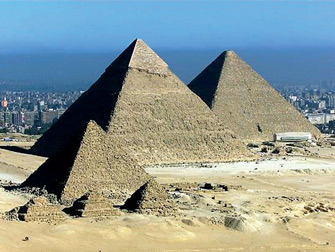|

An aerial view of the Great Pyramids of Giza, south of the
Egyptian capital Cairo, taken in 2000. |
Scientists discover ‘one weird trick’ used by ancient Egyptians
There are many mind blowing things about the pyramids, from the fact
that Cleopatra lived closer to the Moon Landings than the construction
of the Great Pyramid to the idea that they remained the tallest man-made
structures on Earth for more than 3,800 years.
However, one of the most basic and staggering facts about these
colossal constructions is that they were even built in the first place.
Just how did the ancient Egyptians shift stones weighing as much as
2.5-tonnes with technology no more complex than a sledge?
Now, a group of physicists say that they’ve uncovered that ‘one weird
trick’ that helped ancient engineers drag the huge stones across the
desert. The magic ingredient? A little water. Researchers from the
University of Amsterdam and the Foundation for Fundamental Research on
Matter found that by wetting the ground in front of their sledges,
ancient Egyptians would have been able to pull large blocks of stones
and statues across the desert without the sand piling up in front of the
vehicle.
“Everyone who has been to the beach will know that dry sand doesn’t
make good sandcastles - the grains slump into a puddle when the bucket
is lifted,” reads the report, published last week in the journal
Physical Review Letters.
“Adding water can solve this problem: the grains stick and the castle
holds its shape. This is great for sandcastle building, and also, it
turns out, for sand transportation.
|

The wall painting from the tomb of Djehutihotep which
scientist believe shows the water trick in action. |
“In the presence of the correct quantity of water, wet desert sand is
about twice as stiff as dry sand. A sledge glides far more easily over
firm desert sand simply because the sand does not pile up in front of
the sledge as it does in the case of dry sand.”
The physicists tested their theories by creating miniature
recreations of the sledges and stones, measuring the amount of force
needed to pull a weight and the stiffness of the sand in relation to the
quantity of water.
Interestingly, the evidence for this discovery has been staring
scientists in the face for millennia. A wall painting from the tomb of
the ancient nomarch Djehutihotep shows the transportation of a massive
statue with an individual seen pouring water in the path of the sledge -
a detail that had had previously been dismissed as part of a
purification ritual.
- The Independent
|

